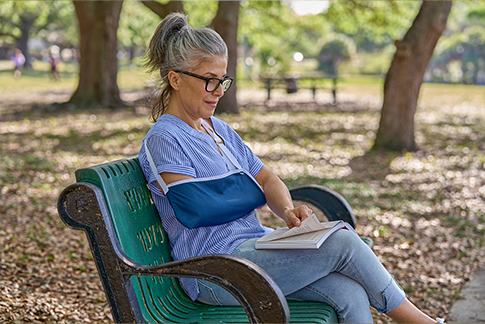How to Choose and Wear a Clavicle or Shoulder Brace
Did you know that the clavicle — or collarbone — is one of the most frequently fractured bones? Most shoulder injuries, on the other hand, involve muscles, ligaments, and tendons instead of bones. The shoulder is the most moveable joint in your body, and its wide range of motion means it’s prone to many types of injury.
When you hurt your clavicle or shoulder, a brace, sling, or support may help the recovery process. Follow your healthcare provider’s instructions for when and how to wear a shoulder support.
Types of Clavicle and Shoulder Braces
A figure 8 clavicle brace loops around both shoulders, holding the shoulders back and restricting movement of the upper body. Usually a clavicle brace will have thick, padded straps and Velcro fasteners for a custom fit. You can wear a clavicle brace on top of or underneath your clothing. Sometimes, these clavicle braces are called posture correctors.
A clavicle sling keeps your arm and shoulder correctly positioned while your clavicle heals.
A shoulder immobilizer is similar to an arm sling, but it’s more restrictive. Shoulder immobilizers typically include a cradle for the arm with a wrist band that connects to a band worn around the chest. It holds the arm at about a 90-degree angle, helping your shoulder injury to heal.
Shoulder stabilizers or supports consist of a neoprene sleeve worn around the upper arm and shoulder and a band worn across the chest, under the opposite armpit. Shoulder stabilizers provide compression and gentle support for shoulder instabilities, rotator cuff injuries, arthritis and other shoulder conditions.


Conditions That May Require a Clavicle Support or Shoulder Brace/Sling
Clavicle fracture: A hard fall, car accident or other trauma can easily fracture the collarbone. If you experience a clavicle fracture, you may feel pain and notice swelling, a lump, or a deformity around the collarbone. Other symptoms include difficulty moving your arm or shoulder, a shoulder that’s sagging, and a cracking or grinding noise when you try to raise your arm. You should seek medical care right away if you think you’ve fractured your clavicle.
Scapula fracture: The scapula (shoulder blade) can be broken in a traumatic event, such as a car accident or a fall. Often, a fractured scapula can heal if you wear a sling to hold the shoulder in place.
Shoulder surgery: Surgery may be required for several common shoulder conditions, such as biceps tendinitis, a glenoid labrum tear, or a rotator cuff injury. After surgery, a shoulder sling or immobilizer is typically prescribed for a period of time.
Shoulder separation: The term “shoulder separation” actually means an injury to the acromioclavicular joint (AC joint), where the collarbone meets the shoulder blade. It’s frequently caused when a hard fall injures the ligaments of the AC joint. A sling is often recommended after an AC joint injury.
Shoulder strain or sprain: When the shoulder muscles or tendons are overstretched or torn, that’s a shoulder strain; torn or stretched ligaments mean a shoulder sprain. Both conditions are usually treated with rest, ice, and immobilization with a shoulder sling.
Dislocated shoulder: When the end of the upper arm bone (humerus) is pulled out of its socket (glenoid), that’s called a shoulder dislocation. Dislocations can be partial or complete, and both are painful conditions. Once your doctor replaces the bone in its socket, you may need to wear a sling or shoulder immobilizer for several weeks.
Rotator cuff injury: The rotator cuff is a group of four muscles and tendons that attach your arm bone to the shoulder blade and help you lift and rotate your arm. Falling on your arm, lifting something that’s too heavy, repetitive stress on the shoulder and age-related degeneration all can cause the rotator cuff to tear. A shoulder sling or immobilizer may be prescribed for minor rotator cuff injuries, or after surgery.
Biceps tendon tear: The upper end of your biceps muscle is attached to bones in the shoulder by two tendons. A fall, heavy lifting or overuse of the shoulder can cause the biceps tendon to tear, fully or partially. Depending on the severity of the tear, your healthcare provider may recommend ice, rest and/or wearing a shoulder sling.
Tips for Wearing a Shoulder Brace or Sling
- With a sling or shoulder immobilizer, make sure the shoulder strap is tight enough to support your arm. Your wrist should rest above your belly button.
- Don’t tighten the sling or immobilizer too much. If your arm or hand feels tingly or numb, or if it changes color, loosen the straps right away.
- Typically the Velcro on your shoulder sling or immobilizer is used to adjust the size to fit your body. If that’s the case with your sling, don’t undo the Velcro when you need to take off the sling. Instead, undo the clips.
- When sitting or lying down, use folded towels to position your arm correctly, with your elbow in front of your body.

Related Poducts
Source
Biceps Tendon Tear at the Shoulder (OrthoInfo)
Clavicle Fractures (Johns Hopkins Medicine)
Dislocated Shoulder (OrthoInfo)
Dr. Trent McKay: Tutorial On Using a Sling After Shoulder Surgery (Olympia Orthopaedic Associates)
How to Put on a Shoulder Immobilizer or Sling While Standing (Mayo Clinic)
Rotator Cuff Tears (OrthoInfo)
Scapula (Shoulder Blade) Fractures (OrthoInfo)
Shoulder Immobilizer (Drugs.com)

